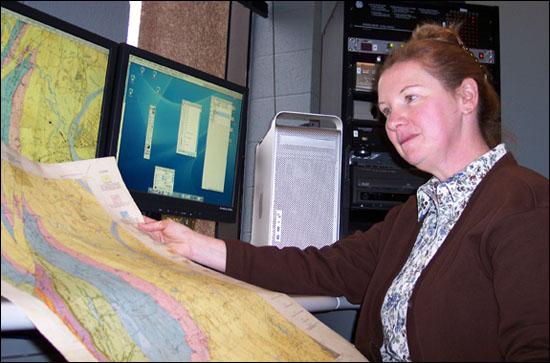Digitization Specialist Creates Digital Instruction Materials
 |
| Allynn Wilkinson, digitization specialist, works on scanning and piecing together a map of Middletown inside the Information Technology Services digitization lab. |
| Posted 03/15/05 |
|
Allynn Wilkinson is leading Wesleyan into a digital world. As Wesleyans digitization specialist, Wilkinson support curricular instruction by converting and creating multimedia instructional materials. And campus wide, technology seems to be contagious. We give faculty members what they need, and that gets other people interested in these types of services, she says. Its just amazing what we can do nowadays with technology. Wilkinson works in her own digitization lab at Information Technology Services. There, she uses five computers to convert one medium into another. Music from a cassette tape can be transferred to a digital audio tape; video from a High 8 tape can be burned onto DVDs, slides from an art portfolio can be scanned and put on Web sites; and data from floppy disks can be burned to CDs. Right now, Im converting a concert that was shot on mini digital video, to a DVD, Wilkinson says, pointing to a computer, processing information. And here, Im scanning a giant map for a geology class. Its so big, it wont fit on the scanner all at once, so I scan it in pieces and put it together on the computer. Adobe PhotoShop is Wilkinsons most-used program for digital image manipulation. She also uses Final Cut, DVD Studio Pro, Adobe Audition and iMovie. I set them up, but the computers do most of the work, she says. Although she devotes much of her day to technical processes such as scanning slides, posters or transferring data, she loves to tackle creative projects that come by her desk. Wilkinson opens her latest project, a digital photography slide show, for Jerry Wensinger, a professor emeritus for the German Studies Department. Wensinger photographed scenes in Munich, Germany, in 1948 and shot the same scenes in 2004. Wilkinson morphed the 1948 black and white images with the recent color photographs to show the before and after. Wensinger will present the slide show to German classes or public talks. This is one of my favorite projects, Wilkinson says, watching the presentation. Each computer is set up to do different tasks. One has a flatbed scanner, another prints directly onto CDs and DVDs. Another computer is setup to make mini-movies called videostreams, which are becoming a popular teaching tool campus wide. Anthropology Professor Betsy Traube uses Digitization Services to transform episodes of The Sopranos TV show into streaming videos for television course; Molecular Biology and Biochemistry Associate Professor Michael McAlear records his lectures onto VHS tapes, which Wilkinson transfers to videostreams for students to view online. “I think having video streams is a great idea, because it gives students the opportunity to see classes that they might want to review, or might have missed due to sickness or other obligations, McAlear says. Seeing the video of the lecture is a much better way to get the information, rather than copying notes from friends. I’ve only had good feedback from it.” Wilkinson said professors and students alike appreciate the convenience of on-demand video. It saves class time when students can watch video assignments on their own time and they can review the material as often as they want, she says. One of Wilkinsons up and coming projects is to turn videos of a brain dissection into streaming videos for Psychology Professor Harry Sinnamons neuroanatomy class. He formerly used VHS tapes. Allynn did a fine job converting the tapes to the streaming video format, Sinnamon says. With no significant cost in resolution, we gained the benefits of convenient access, increased security, and minimized wear and tear on the tapes. I would recommend this service to any instructor who uses the same tapes from year to year. Wilkinson, who holds a bachelors degree in Victorian studies, and masters degrees in pop culture and library science, acquired much of the technology on her own time. She learned to stream videos by recording soap opera clips, and time-lapse movies of flowers blooming. I have all these machines here. If someone brings me something Ive never seen, Ill figure it out, she says. Shes had a few cases where professors have brought her outdated hard drives, audio recorders and little silver things, but shes always found a way to open, extract and re-record the material on more up-to-date formats. Were always up for learning new things, she says. When not in the lab, shes attending intellectual property committee meetings and works as a media digitations specialist for Leaning Objects, which are graphical simulations, data sets or learning modules that can replace text or lectures on a subject. Wilkinson, 44, celebrated her one-year anniversary at Wesleyan in December 2004. Prior to Wesleyan, worked part-time for Brown University, also as a digitization specialist. Wilkinson, who lives in Pawcatuck with her pet parrot and cat said once shes home, she resorts to less techy hobbies, such as decorating her house and gardening. I have a lot of computers at home, but I try hard not to turn them on, she said. |
| By Olivia Drake, The Wesleyan Connection editor |

